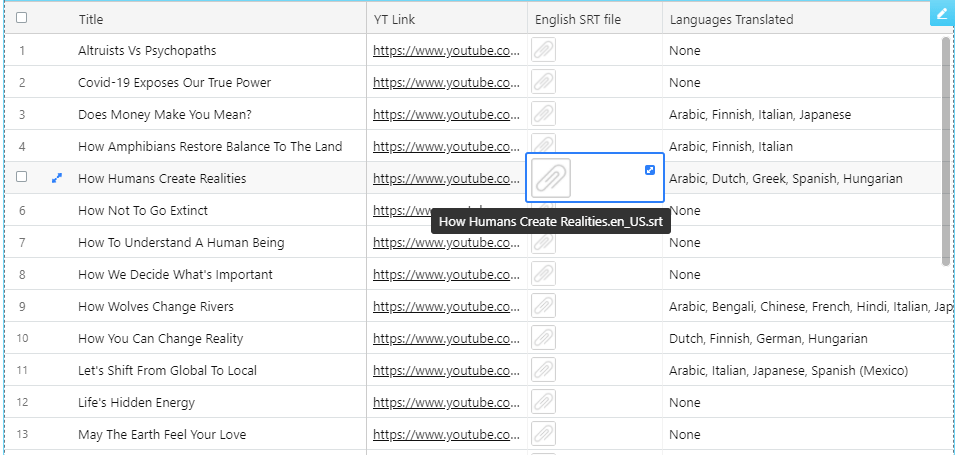Fisheries and Ocean Canada has the job of trying to balance commercial fishing interests with ecosystem preservation. Part of that job is educating the public about endangered species. Together, we worked with many scientists to bring their valuable research to life with intrigue and wonder in a series of five videos – each on a different endangered species. Here are all five videos in the series:
WHITE SHARKS
BLUE WHALES
NORTH ATLANTIC RIGHT WHALES
LEATHERBACK SEA TURTLES
WOLFFISH
WHITE SHARKS
Perhaps no other animal in the ocean is more well known than the White Shark, also known as the Great White Shark. But despite their fame and reputation, they may also be the least understood. White Sharks, aptly named for their bright white bellies, are actually two different colours. Their top half is dark grey-brown, while their lower half is white; this allows them to blend in with deep water from above and with the sky from below. This colouration makes them harder to detect by their prey, which consists mainly of fish, seabirds, and seals.
As predators at the top of the food chain, sharks play an important role in maintaining the health of the entire ocean ecosystem. White sharks have a notable impact on the behavior of their prey, changing their feeding habits and diet and helping to remove the weak and the sick.
These large fish have probably been in Atlantic Canadian waters for longer than we thought, but technology and media coverage is increasing our awareness of their presence. While the movies and the media often portray these large predators as ruthless killers, situations where White Sharks injure humans are extremely rare and often occur when people are mistaken for seals.
The currents that flow through the Gulf of St. Lawrence bring an abundance of fish and marine life. The rocky and tidal coastlines are ideal for colonies of seals to come ashore to mate and rest. The coastal and offshore waters here also provide an abundance of food for seals. The large number of seals in the Gulf is an inviting feeding ground for White Sharks.
However, White Sharks are listed as endangered in Canada under the Species At Risk Act. Threats to their populations include fishing, marine pollution and climate change. While the habits and migrations of White Sharks are still largely a mystery, science is helping us to better understand their movements. In 2018, the first White Shark was tagged off the coast of Nova Scotia, in Canada. That shark stayed in Canadian waters for two months, allowing scientists from Fisheries and Oceans Canada and their partners to collect valuable information on water temperature, diving behavior, and the shark’s location as it travelled through the area. Tagging White Sharks is helping us to understand why and how they are using the Gulf of St. Lawrence and giving us information about these animals that are an integral part of our ocean’s ecosystems.
BLUE WHALES
Blue Whales are found in oceans around the world. Atlantic Blue Whales are listed as endangered in Canada under the Species at Risk Act. There are likely less than 250 mature animals. The number of Atlantic Ble Whales decreased in the 1800s because of whaling, but whaling in Canada came to an end in 1966.
Today, Blue Whales still face many threats caused by humans. These include vessel strikes, pollution in the water from chemical spills, and getting tangled in fishing gear. The food sources for Blue Whales are also being affected by climate change.
Blue Whales live off the coast of Eastern Canada, including the Gulf of St. Lawrence. They are found in these waters especially during the summer months.
The Blue Whale is the largest animal that has ever existed on Earth! The longest Blue Whale seen so far was 30 metres long. Thats’ about the length of 3 school buses!
Blue Whales are usually found alone and are often hundreds of kilometres apart. To communicate with each other over these long distances, they use sound. Sound can travel up to 5 times further through water than it can through the air. Blue Whales use loud, low-frequency songs and calls that are heard deep in the oceans from THOUSANDS of kilometres away. Some of their calls are louder than a space shuttle launch! Scientists can even use their songs to tell where they come from because their songs often vary from one region to another. Blue Whales make sounds and calls to communicate with each other, to find food, to attract a mate and to navigate. Their calls can sound like noisy human activities in the ocean. These include ship noises, sonar used for navigation, and sounds used in seismic surveys to find marine oil and gas sources.
Noisy environments can change whale behaviours and activities. This includes making whale to whale communication harder. That can force Blue Whales to increase the number and volume of calls. It might also make them avoid noisy areas altogether. Today, all these new noises in the ocean mean that a Blue Whale call might be heard from only 200 kilometres away, or even less! This is a big change compared to Blue Whale songs travelling up to 2000 kilometres away centuries ago.
Fisheries and Oceans Canada as well as Transport Canada are helping to address ocean noise by funding research and additional work with partners throughout Canada which will help Blue whales communicate easier and help other marine animals that depend on quieter oceans to survive!
NORTH ATLANTIC RIGHT WHALES
North Atlantic right whales live in the Atlantic Ocean. They are usually found in coastal waters between Florida and Newfoundland. The right whale is one of the large whale species the most at risk of extinction in Canada. They are listed as endangered under the Species at Risk Act. Right Whales were hunted to near extinction as they were considered the right whale to hunt because they are slow-moving and their bodies float when they are dead.
Although whaling no longer occurs for right whales in North America, they are still critically endangered. They may be accidentally caught in fishing gear or be harmed by vessel collisions. Ocean noise and climate change can also pose risks to these whales
Female right whales typically give birth to their calves in southern Waters off the east coast of the United States during the winter. In the summer months, right whales move to cooler Waters in places like Atlantic Canada to feed. Right whales feed on copepods, tiny aquatic animals about the size of a grain of rice that is full of fat. Whales need to eat a lot of copepods to store fat and stay healthy. An adult right whale can eat more than 900 kg of copepods in one day. In the past, right whales almost always feed in the Gulf of Maine, the Bay of Fundy and off the southern coast of Nova Scotia. Since 2015 however, a shift has happened that surprised scientists. The whales seem to have moved away from their traditional feeding areas.
Climate change is causing ocean waters to warm and marine animals are adopting to find different sources of food. Because of climate change, both the number of copepods available and their quality as food sources have changed. As a result, right whales are eating different copepod species and large numbers of whales are now seen in areas where they were less common in the past. In recent years, more right whales have been seen in the Gulf of St. Lawrence most likely to find new food sources. This area is now considered important to the survival of Right whales.
Scientists, industry, and the public are working together and using information gathered through research and monitoring to better understand the North Atlantic right whale population. They are also finding ways to manage human activities so that they have less of an impact on right whales. The government of Canada is continuing to track and study North Atlantic right whales and is developing new ways to protect them.
With all the efforts being made to help them, there is hope that North Atlantic right whales can grow in number to become a healthy and stable population.
LEATHERBACK SEA TURTLES
Leatherback Sea Turtles have been travelling the world’s oceans for over 100 million years. Their unique teardrop-shaped bodies and long, powerful front flippers are built for swimming long distances and diving to great depths. They can grow to be true giants, weighing in at as much as 900 kilograms and up to 2 metres long, making them the largest living reptile on earth. Leatherbacks spend their whole adult lives in the ocean, except for mature females when they haul their large bodies ashore on warm, sandy beaches every 2-3 years to lay their eggs. covering them, and returning to the sea.
When the turtles arrive on-shore, females dig a deep nest cavity using just their flippers before laying about 80 eggs, It is estimated that only 1 out of 1000 eggs will survive to be healthy, adult turtles.
Leatherbacks are highly migratory animals, which means they travel long distances.
In the Atlantic Ocean, adult and sub-adult Leatherback Sea Turtles move beneath the warm waters off Central and South America, the Caribbean, and Florida in the winter, where they feed and reproduce, to temperate waters off Atlantic Canada in the late spring through fall.
Jellyfish are found in high concentrations in the Gulf of St. Lawrence throughout the summer and fall because of the currents around Nova Scotia and through the Gulf. While in Atlantic Canadian waters, Leatherbacks love to eat Jellyfish, eating more than their body weight in a single day. This helps keep jellyfish populations from getting too big.
Leatherback turtles are an endangered species in Canada. Accidental capture and getting tangled in fishing gear like trawls, longlines and gillnets are major threats to sea turtles. One way you can help protect sea turtles is by using less plastic. Plastic bags can resemble jellyfish and Leatherbacks might mistake them for food. Bags and other plastic waste has been found in their tracts, which can harm or even kill the turtles.
If you see a Leatherback Sea Turtle in Canada, please report the sighting to your region’s sea turtle network or Coast Guard. We can all play an important role in keeping the prehistoric giants safe.
WOLFFISH
Wolffish are large unique fish that live at the bottom of the Atlantic and Arctic oceans in waters as deep as 1000 metres. Water that deep is too cold for many other marine species but Wolffish can tolerate the cold by making antifreeze proteins in their blood.
Wolffish get their name from their sharp wolf-like teeth. In the waters off Canada’s east coast there are three different species of Wolffish; the Spotted Wolffish named for the spots on its skin; the Northern Wolffish which has darkly coloured jelly-like flesh and the Atlantic Wolffish which is striped.
Wolffish eat shellfish and urchins that are too hard for most other fish to eat, and this has a positive impact on their ecosystem. Seaweeds like kelp can thrive when the sea urchins that eat them are kept in check by Wolffish. The presence of seaweed helps to maintain a healthy and diverse ecosystem.
Recently there has been a decline in Wolffish numbers that has been most dramatic for Spotted and Northern Wolffish. Under Canada’s Species at Risk Act, the Spotted and Northern Wolffish are listed at ‘Threatened’. The Atlantic Wolffish is currently listed as a ‘Special Concern’. This means it is at risk of becoming a Threatened or Endangered Species.
Wolffish are often caught by mistake in nets or other fishing gear meant for catching other fish species. This is one of their greatest threats in terms of human activities. Today, fishers are learning more about Wolffish and their importance in the ecosystems they live in.
One way fishers are helping with the recovery of Wolffish is by safely releasing them when they are caught. When they are placed back in the water quickly and with minimal handling, they have a good chance of surviving. When fishers record and report interactions with Spotted and Northern Wolffish to Fisheries and Oceans Canada, the recovery of the species is easier to track. Management measures like these along with continued research will help ensure Wolffish continue to survive, and thrive in Canadian waters.
Video scripts were written by scientists at Fisheries and Oceans Canada.
“A huge thank you to Chris and Dawn Agnos from Sustainable Human for producing these videos. Holy smokes…I am still enthralled with these! The music, the imagery, the sound engineering…all superb. I am deeply proud to have participated in the making of these beautiful learning tools. They will be excellent tools to have in our toolbox in promoting the survival and recovery of our listed species. The VO quality along with the images and music really make these feel like productions from a major Network or streaming service. You guys are quite the rockstar!”







